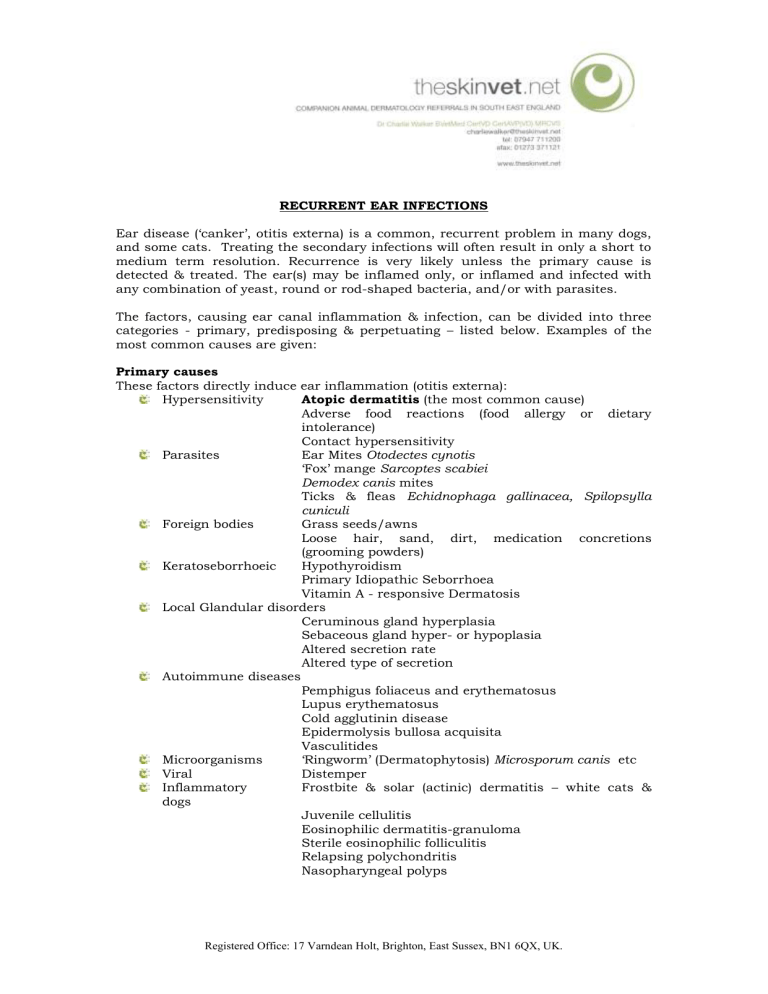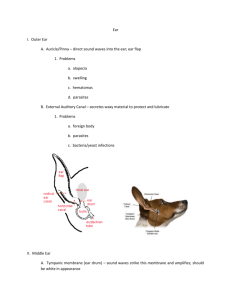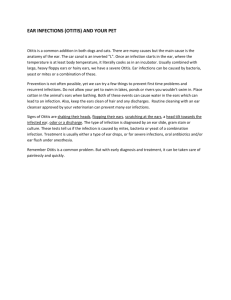TheSkinVet Recurrent Ear Infection Information Sheet

RECURRENT EAR INFECTIONS
Ear disease (‘canker’, otitis externa) is a common, recurrent problem in many dogs, and some cats. Treating the secondary infections will often result in only a short to medium term resolution. Recurrence is very likely unless the primary cause is detected & treated. The ear(s) may be inflamed only, or inflamed and infected with any combination of yeast, round or rod-shaped bacteria, and/or with parasites.
The factors, causing ear canal inflammation & infection, can be divided into three categories - primary, predisposing & perpetuating – listed below. Examples of the most common causes are given:
Primary causes
These factors directly induce ear inflammation (otitis externa):
Hypersensitivity Atopic dermatitis (the most common cause)
Adverse food reactions (food allergy or dietary intolerance)
Parasites
Foreign bodies
Contact hypersensitivity
Ear Mites Otodectes cynotis
‘Fox’ mange Sarcoptes scabiei
Demodex canis mites
Ticks & fleas Echidnophaga gallinacea, Spilopsylla
cuniculi
Grass seeds/awns
Loose hair, sand, dirt, medication concretions
(grooming powders)
Keratoseborrhoeic Hypothyroidism
Primary Idiopathic Seborrhoea
Vitamin A - responsive Dermatosis
Local Glandular disorders
Ceruminous gland hyperplasia
Sebaceous gland hyper- or hypoplasia
Altered secretion rate
Autoimmune diseases
Altered type of secretion
Pemphigus foliaceus and erythematosus
Microorganisms
Viral
Inflammatory dogs
Lupus erythematosus
Cold agglutinin disease
Epidermolysis bullosa acquisita
Vasculitides
‘Ringworm’ (Dermatophytosis) Microsporum canis etc
Distemper
Frostbite & solar (actinic) dermatitis – white cats &
Juvenile cellulitis
Eosinophilic dermatitis-granuloma
Sterile eosinophilic folliculitis
Relapsing polychondritis
Nasopharyngeal polyps
Registered Office: 17 Varndean Holt, Brighton, East Sussex, BN1 6QX, UK.
Predisposing factors
These increase the risk of development of ear disease but do not directly induce it:
Conformation Long, dangling ear flaps (pendulous pinnae)
Hairy ear canals (hirsutism)
Stenotic canals
Excessive moisture ‘Swimmer’s ear’
High humidity environment
Excessive cerumen (wax)
Treatment effects Hair plucking (Groomers)
Cotton bud trauma
Obstructive disease Benign cutaneous neoplasia
Systemic disease
Polyps
Immune suppression or viral disease
Generalised neoplastic disease
Debilitation and negative catabolic states
Please note the first factor, conformation of the ear, does not directly cause ear disease. This is a common misconception. If this was true then all dogs with large, floppy, and/or hairy ears would have recurrent ear infections.
Perpetuating causes
These factors prevent resolution of the disease.
Yeast
Bacteria
Pseudomonas sp. (Proteus sp., Escerichia coli etc.)
Progressive pathological changes (from chronic inflammation and recurrent infections)
Malassezia pachydermatis; Candida sp.
Staphylococcus pseudintermedius, (Streptococcus sp.)
Ceruminous Gland hyperplasia
Disruption of elevator clearance mechanism
Fibrosis - scarring
Hidradenitis
Hyperkeratosis
Hyperplasia – increased epithelial folds
Oedema – swelling
Ossification of ear cartilage
Otitis media (middle ear disease)
Simple purulent
Caseated or keratinous
Choleastoma
Proliferative
Destructive osteomyelitis
Therefore the more infections that a patient undergoes the more difficult it may be to reverse the progression of the ear disease.
Eventually permanent damage will ensue and surgical treatment will be the only option through re-referral to a Soft Tissue Surgeon for salvage surgery (total ear canal ablation with bulla osteotomy).
Registered Office: 17 Varndean Holt, Brighton, East Sussex, BN1 6QX, UK.





